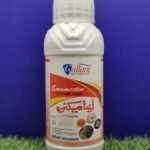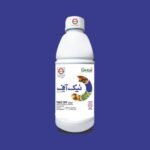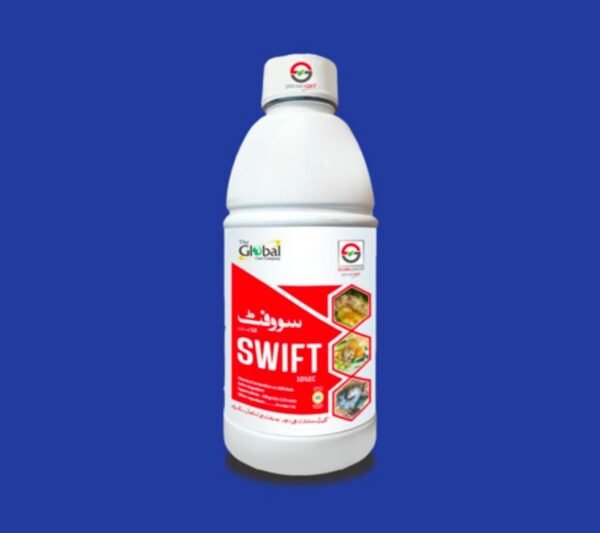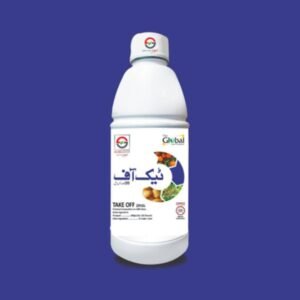SWIFT Cypermethrine 250 ml
₨ 500 ₨ 600
Active ingredient: Cypermethrin, a synthetic pyrethroid (IUPAC: [Cyano-(3-phenoxyphenyl)methyl]-
Typical concentration: Often labeled as 10% EC (emulsifiable concentrate). A 250 mL pack usually contains around 25 grams of active compound .Active ingredient: Cypermethrin, a synthetic pyrethroid (IUPAC: [Cyano-(3-phenoxyphenyl)methyl]-Active ingredient: Cypermethrin, a synthetic pyrethroid (IUPAC: [Cyano-(3-phenoxyphenyl)methyl]
Description
🧪 Product & Formulation
Active ingredient: Cypermethrin, a synthetic pyrethroid (IUPAC: [Cyano-(3-phenoxyphenyl)methyl]-
Typical concentration: Often labeled as 10% EC (emulsifiable concentrate). A 250 mL pack usually contains around 25 grams of active compound .Active ingredient: Cypermethrin, a synthetic pyrethroid (IUPAC: [Cyano-(3-phenoxyphenyl)methyl]-Active ingredient: Cypermethrin, a synthetic pyrethroid (IUPAC: [Cyano-(3-phenoxyphenyl)methyl]
⚙️ Mode of Action
Non-systemic: Kills on contact or ingestion.
Mechanism: Affects insect nervous system by disrupting sodium channels, causing paralysis and death
🎯 Uses
Agricultural: Controls a wide range of pests—leaf-eating caterpillars (Lepidoptera), borers, beetles, flies, aphids, etc.—on crops like cotton, fruits, sugarcane, vegetables
Public health/veterinary: Used against mosquitoes, flies, cockroaches, bed bugs, fleas, and livestock
Household: Found in sprays against ants, roaches, and other common pests .
⚠️ Toxicity & Safety
Human health:Moderate toxicity via skin contact or ingestion. May cause tingling, burning, nausea, headaches, muscle weakness, seizures in severe exposure Classified as “suspected of damaging fertility” and potentially harmful to the nervous system with repeated or high exposures
Environment:
Highly toxic to fish, aquatic invertebrates, bees Persistence in soil ~17–30 days, foliage degradation ~5 days; binds heavily to soil, so low groundwater mobility
Precautions:
Use protective gear: gloves, clothing, eye/face protection, avoid inhaling vapors Store locked and away from oxidizers; dispose of according to local hazardous-waste protocols
🧩 Application & Dosage
Carefully follow the label’s mixing instructions—commonly diluted to 200–500 mg/L in water, depending on crop/pest.Apply when pests are active, avoiding blooming stages in flowering crops to protect pollinators.Do not apply near water bodies or drainages to protect aquatic life.
✅ Summary Table
Category Details Formulation 10% EC, 250 mL bottle Mechanism Contact & ingestion; neurotoxin Controls Insects in agriculture, household pests, livestock parasites Human toxicity Moderate; potential systemic effects Environmental risk High for fish, bees, aquatic insects Degradation Soil half-life 17–30 d; foliage ~5 d Safety gear Gloves, mask, protective clothing Avoid Aquatic environments; pregnant women; direct food contact
📝 Best Practices
Read label thoroughly—follow dose, dilution, and safety guidelines.
Wear PPE: gloves, goggles, long sleeves, and respirator/mask.Avoid pollinator exposure: apply in early morning/evening, avoid blooming crops.
No runoff: prevent drift into streams or ponds.Clean up responsibly: don’t reuse containers; follow disposal rules for hazardous agrochemicals.









0.0 Average Rating Rated (0 Reviews)